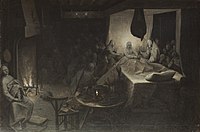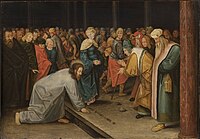Provenance
The painting was not sold by the artist and seems to be the only one inherited by his son Jan Brueghel the Elder. An engraving was published in 1579 by Paul Perret, who apparently lent the painting for the purpose since there are regular pricks along the edges to make a grid. There are a number of other copies, some attributed to the artist's sons, perhaps made after the engraving, and the painting was lent to Cardinal Federico Borromeo for copying (perhaps the version now in Bergamo). [4] A version attributed to Breuegel's son Pieter Brueghel the Younger of c. 1600 is in the Philadelphia Museum of Art. [1]
It was sold by the family in the 17th century, apparently by Jan Brueghel the Younger, and was in England by the 18th century, being sold at Christie's in 1834 and again in 1952 when it was bought by Count Antoine Seilern, whose collection was bequeathed to the Courtauld in 1978. [4] The work was stolen from the Courtauld Gallery on 2 February 1982. [7] Because of its value and fame, it proved unsaleable on the open market and did not resurface again until 1992, when it was recovered by British police. During that interim, it likely acted as collateral for the criminals. [8]

Pieter Brueghelthe Younger was a Flemish painter known for numerous copies after his father Pieter Bruegel the Elder's work, as well as original compositions and Bruegelian pastiches. The large output of his studio, which produced for the local and export market, contributed to the international spread of his father's imagery.

Pieter Bruegelthe Elder was among the most significant artists of Dutch and Flemish Renaissance painting, a painter and printmaker, known for his landscapes and peasant scenes ; he was a pioneer in presenting both types of subject as large paintings.

Grisaille means in general any European painting that is painted in grey.

Upton House is a country house in the civil parish of Ratley and Upton, in the English county of Warwickshire, about 7 miles (11 km) northwest of Banbury, Oxfordshire. It is in the care of the National Trust. The house is Grade II* listed as are the park and gardens.

Netherlandish Proverbs is a 1559 oil-on-oak-panel painting by Pieter Bruegel the Elder that depicts a scene in which humans and, to a lesser extent, animals and objects, offer literal illustrations of Dutch-language proverbs and idioms.

The Blue Cloak, or De Blauwe Huik, refers to an old concept for a popular 16th-century print series featuring Flemish proverbs. The prints were generally captioned according to each depicted proverb, and central to these was a woman pulling a cloak over a man. That proverb is also central to a 1559 painting called Netherlandish Proverbs by Pieter Bruegel the Elder.

The Blind Leading the Blind, Blind, or The Parable of the Blind is a painting by the Netherlandish Renaissance artist Pieter Bruegel the Elder, completed in 1568. Executed in distemper on linen canvas, it measures 86 cm × 154 cm. It depicts the Biblical parable of the blind leading the blind from the Gospel of Matthew 15:14, and is in the collection of the Museo di Capodimonte in Naples, Italy.

Peeter Baltens, Pieter Balten or Pieter Custodis, was a Flemish Renaissance painter, draughtsman, engraver and publisher. Baltens was also active as an art dealer and poet. He was known for his genre paintings, religious compositions and landscapes.

The Adoration of the Kings is an oil-on-panel painting of the Adoration of the Magi by the Netherlandish Renaissance artist Pieter Bruegel the Elder, painted in 1564. It is held in the National Gallery, in London.

Storm at Sea is an oil painting on panel attributed the Netherlandish Renaissance artist Pieter Bruegel the Elder, painted c. 1569. It is held in the Kunsthistorisches Museum, in Vienna.

Conversion of Paul is an oil-on-panel painting by the Netherlandish Renaissance artist Pieter Bruegel the Elder, painted in 1567. It is now in the Kunsthistorisches Museum in Vienna.

The Peasant and the Nest Robber is an oil-on-panel painting by the Netherlandish Renaissance artist Pieter Bruegel the Elder, painted in 1568. It is in the Kunsthistorisches Museum in Vienna.

The Census at Bethlehem is an oil-on-panel painting by the Flemish Renaissance artist Pieter Bruegel the Elder, painted in 1566. It is signed and measures about 1155 × 1645 mm. It is now in the Oldmasters Museum in Brussels, which acquired it in 1902.
Fritz Grossmann, art historian. Born 26 June 1902 in Stanislau,, now Ivano-Frankivsk in Ukraine, died 16 November 1984, Croydon, London) was an Austrian-British art historian.

The Nativity is a devotional mid-1450s oil-on-wood panel painting by the Early Netherlandish painter Petrus Christus. It shows a nativity scene with grisaille archways and trompe-l'œil sculptured reliefs. Christus was influenced by the first generation of Netherlandish artists, especially Jan van Eyck and Rogier van der Weyden, and the panel is characteristic of the simplicity and naturalism of art of that period. Placing archways as a framing device is a typical van der Weyden device, and here likely borrowed from that artist's Saint John Altarpiece and Miraflores Altarpiece. Yet Christus adapts these painterly motifs to a uniquely mid-15th century sensibility, and the unusually large panel – perhaps painted as a central altarpiece panel for a triptych – is nuanced and visually complex. It shows his usual harmonious composition and employment of one-point-perspective, especially evident in the geometric forms of the shed's roof, and his bold use of color. It is one of Christus's most important works. Max Friedländer definitely attributed the panel to Christus in 1930, concluding that "in scope and importance, [it] is superior to all other known creations of this master."

Several oil-on-oak-panel versions of The Massacre of the Innocents were painted by 16th-century Netherlandish painters Pieter Bruegel the Elder and his son Pieter Brueghel the Younger. The work translates the Biblical account of the Massacre of the Innocents into a winter scene in the Southern Netherlands in the prelude to the Dutch Revolt against Spanish rule, also known as the Eighty Years' War.

Landscape with the Flight into Egypt is a 1563 oil on wooden panel painting by Pieter Bruegel the Elder, showing the biblical Flight into Egypt of Mary and Joseph with the infant Jesus. It measures 37.1 by 55.6 centimetres and is held in the Courtauld Gallery, in London.

The Adoration of the Magi in the Snow is a painting in oils on oak panel of 1563, by Pieter Bruegel the Elder, now in the Oskar Reinhart Collection Am Römerholz in Winterthur, Switzerland. With two Italian exceptions, it is thought to be the first depiction of falling snow in a Western painting, the snowflakes boldly shown by dots of white across the whole scene, added when the work was otherwise completed.

Winter Landscape with a Bird Trap, also known as The Bird Trap, is a panel painting in oils by the Flemish painter Pieter Bruegel the Elder, from 1565, now in the Oldmasters Museum in Brussels. It shows a village scene where people skate on a frozen river, while on the right among trees and bushes, birds gather around a bird trap. It is signed and dated at the lower right: "BRVEGEL / M.D.LXV’1". There are more early copies of this than any other painting by Pieter Bruegel the Elder, many by his much younger son Pieter Brueghel the Younger, or other members of the Brueghel family dynasty and workshop. The art historian Klaus Ertz documented 127 copies in his comprehensive monograph on the artist's son in 2000.

The Death of the Virgin, also known as The Dormition of the Virgin, is a 1564 grisaille painting by Dutch and Flemish painter Pieter Bruegel the Elder, depicting the death of the Virgin Mary with the Apostles and other figures in attendance. It is now displayed in Upton House and under the care of the National Trust. It is one of the three surviving grisailles by Bruegel.























